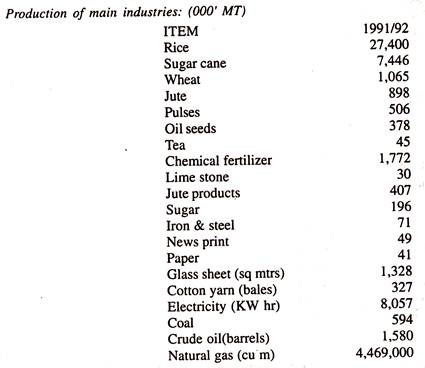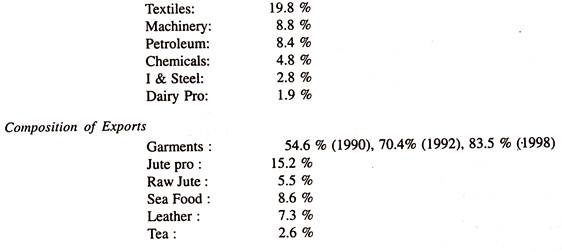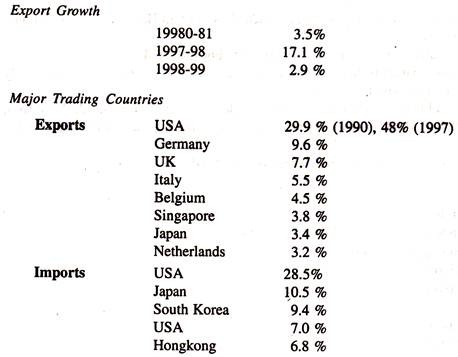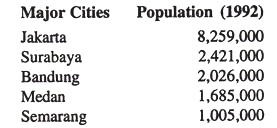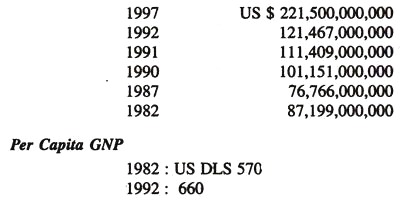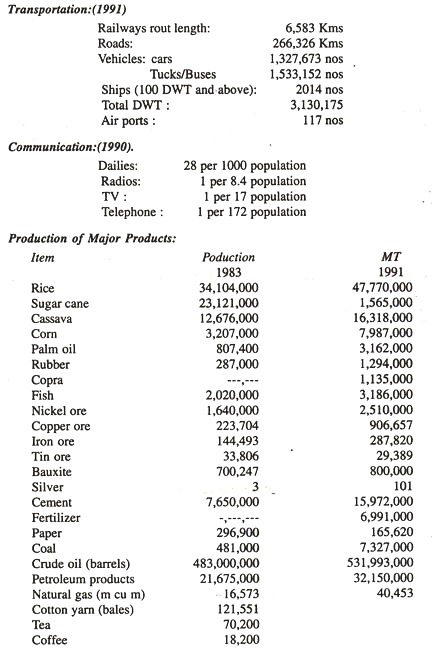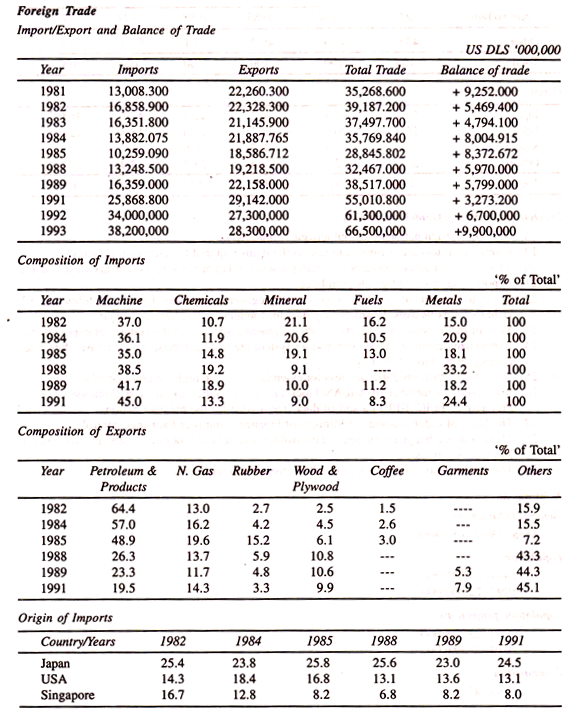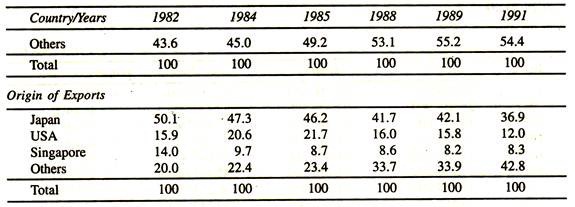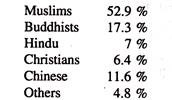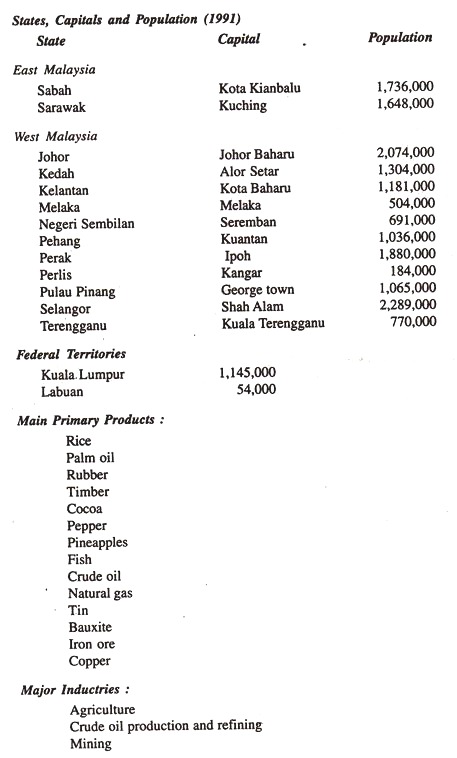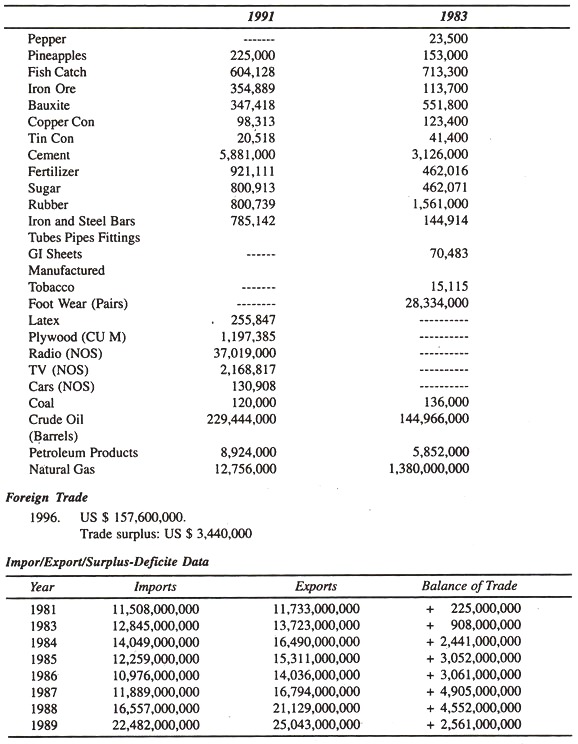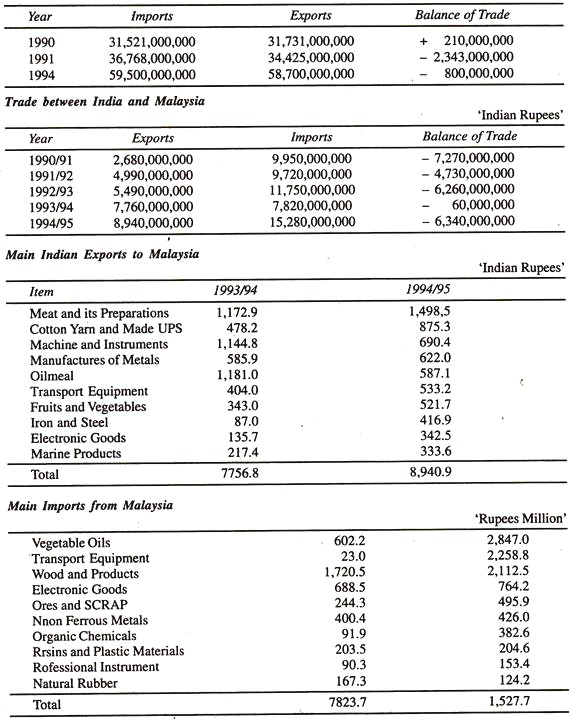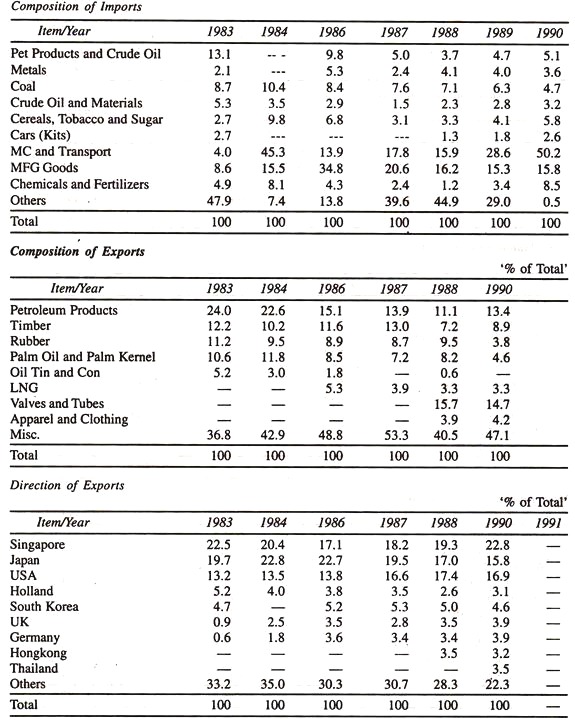This article provides a comparative study of the foreign trading policy.
Study of the Nation as One Unit:
A nation is a collection of economic utilities in different forms like land, products & means of production, and the people that make use of these utilities. The laws of governance & control of the land tie these together into a uniform force that is an indicator of the strength of the nation.
The last part “strength of the nation” is the driving force that motivates the nations for singular and/or collective effort for creation of better living conditions. The creation of world bodies like UNO, WB, WTO, ICC and various trading blocks like NAFTA, EU, ASEAN, SAARC etc. are but for this driving force.
The character trait of ‘economic utility’ of the nations compels them for cooperation, expansion, and domination with and over the other similar forces, which under the current phase of civilization is by means of peaceful negotiation process well defined and guarded under a universal uniform code of conduct.
The study of a nation is thus directed towards identification of these utilities and strengths for the purpose of “cooperation, expansion, and domination” of one over the other for mutual benefit.
Imports and exports are the two channels of the international business. We either want to import and/or export something, or we want to invest or get investment, and/or control and direct a nation that might be causing concern to our own export policies or affecting existing export markets.
These are some of the issues that affect or threaten to affect our interests in the global markets. The study of a nation also helps us in this direction.
Most of the world trade is conducted by the private sector organizations but the public sector and the national governments are also large players. The international trade is governed by set rules and guidelines. These are formulated by the national governments to develop, protect, and expand not only their business but also their area of influence.
Each nation has its set of rules and guidelines. Sometimes these rules and guidelines conflict with those of other nations and thus creating a stage of confrontation. Sometimes these issues are resolved mutually and some through the services of specialized organizations like WTO and ICC. These are some of the reasons that explain why we need to study the nations as the unit of international trade.
As far as the students of international business are concerned, this study is a must and is perhaps one of the most active aspects of business studies. It not only broadens their outlook but also increases their level of awareness of what is going around the world.
It conditions them to play their role positively when time comes for them to play. They gain useful insights into the economy of a nation and as well get first hand information about the areas of potential interest to them.
The classroom study can lead and shape the future. In the era of Internet and globalization of information and communication, the students are now well equipped and informed to conduct these studies at macro and micro levels which enriches and benefits both the institution and the student.
Once the students start taking keener interest in a particular region/nation they must be encouraged to study the language and culture of that region/ country so that by the time they enter or are ready to enter the global market, they are already professional for that region.
In many management institutions especially those that also teach international business the selection of the region of interest and the language/cultural studies to be taken up by the students has to be conducted professionally through effective counseling.
What Must Be Studied?
The answer to this question lies in our purpose for study or line of interest. If we want to invest in the infrastructure of a country, than our line of approach would be the national policy of that country for that specific sector and existing situation of the infrastructure.
If the country is itself interested in inviting foreign investment in that sector than the foreign trade policy will have a statement on this topic like incentives and the areas of potential interest to the foreign investors.
If we are looking for the overseas markets for investment than we want to make sure our investments will be secure and will generate returns commensurate with investment and that the local laws do not hinder the repatriation of the profits.
If we want to export than we want to make sure that the country has the capacity to make the payment. If we want to import we want to make sure that not only we get what we contracted for but also in time and in good condition.
The Study:
The guidelines and the conduct of the international business are reflected in the foreign trade policy of any country that is an external expression of the national government. It is based on numerous domestic factors and the direction of the growth as anticipated by the national government.
The government’s line of thinking is reflected in the Policy statement with supporting explanatory notes covering various areas that the national government intends to highlight for attracting the world trading community and nations.
This study is divided in two parts:
Part-1. Internal factors.
Part-2. External factors.
The first part covers the ground realities of the nation as indicated by specific study of numerous factors and the second part covers the foreign trade policy statements by the national governments.
Part-1:
The Internal Factors:
The purpose of this study is to know the country’s general information, economic and political condition, infrastructure, and trade and trade relations.
Following items are most appropriate for this study:
(a) Population
(b) Literacy
(c) Technical education
(d) Unemployment
(e) Per-capita income
(f) Relationship with neighboring countries
(g) Political situation and stability factor
(h) GDP and GNP studies.
(i) GDP vs. Trade relationships
(j) Foreign debt and GNP
(k) FDI position
(l) Balance of payment position
(m) Infrastructure (rail and road transport, ports, telecommunication, power).
(n) Tax structure and legal set up.
(o) Relationship with regional trade blocks.
(p) Relationship with WTO, WB, IFC, IMF etc.
(q) Imports direction and composition (minerals, agro-products, industrial products, consumer products, services and related technology)
(r) Dependence on imports.
(s) Exports direction and composition (minerals, agro-products, industrial products, consumer products, services and related technology)
(t) Dependence on exports
(u) Export emphasis (low-tech, medium tech, and high technology)
Each of the above items gives unique piece of information that can be selectively used by the students for arriving at conclusions.
Items a to e: These are for general information of the nation.
Items f & g: It gives the political information.
Items h to l: These items give information on the economic conditions.
Item m: “Infrastructure” is an important item since any investor and trader at first would like to know details on this point to make up his decision whether doing business with/to/from that country would be smooth or risky.
Item n: It gives information on the existing tax structure and other legal aspects of doing business. This is an important indicator that helps the foreign investors or other parties intending to do business, to know the safety factor of their investment, repatriation of profits, and conflict resolving mechanism.
Items o & p: These points indicate the conditions of trade relations with other trading blocks, nations and international institutions.
Items q to u: These items are the indicators of global trade (volume, direction, destination/origin, dependence and technological level)
Most of the data for this study and even for the next part comes from the secondary sources like the trade journals, annual reports by the country and WTO, WB, IMF etc., and the import & export data published by the national government. The extracted information gives us the decision making power for doing business with that country.
Part-2. The External Factors:
The “Foreign Trade Policy” constitutes the major field of study for the external factors. Foreign trade policy of a country is a policy statement of the national government that covers the present status and achievements and provides directional approach for the future course of action to achieve set goals of national importance for international impact.
It also has two elements, one the domestic environments (economy, industry, legal, demand and supply conditions, infrastructure etc.) and the second is the national government’s desire for global expansion and adjustments.
The word “expansion” has two meanings; the explicit meaning refers to the national need for comfortable global currency reserve position, and the implicit meaning is the hidden desire for increasing the are of influence in the global markets both economically and politically.
The second word “adjustment” means the negotiated settlements of trade relations with the other nations and/or organizations like WTO, WB, IMF etc., for improving the trade relations and for projecting the nation as a progressive and accommodating state to attract not only the FDI but also the talents on global basis.
The “policy statement” that is issued by the national governments is an expression of intentions. If you study these statements of different governments you will find appreciable difference in the contents and meaning, in what is expressed and what is hidden between the lines. The statement is clear indicator of what the government is, a powerful developed nation, a developing nation, or the least developed nation.
The statement of a developed nation projects sense of power and what it wants, the statement of a developing country is projected as what they are and/or can do, and that of the least developed country projects a sense of invitation directed towards the overall developmental requirements.
In the present context of global competitiveness of economy, the line dividing the local trade and foreign trade is diminishing; trade in one sector affects the other sectors directly and/or indirectly. Foreign trade policy cannot be formed in total seclusion and so is the domestic trade policy.
The basic purpose of the policy statement is to explain “what we are and what we intend to do”. It is focused on the national government’s efforts to expand (exports), strengthen (current position), and attract (foreign investors). It also elaborates on the industrial, economic, and legal, side of the nation.
This policy can also be viewed as the national publicity campaign launched by a state department on behalf of the nation as a sales tool. It is similar in extent and approach as done by any MNC for launching its corporate image either to create awareness or to brand it in a specific way and for specific target audience.
The end result is always the same. Either the public awareness (national and/or international) increases or it is rejected right away. The impact of the policy statement can vary between total awareness and interest or total rejection. The success of the policy/advertisement would depend on the explicit/implicit meaning, sincerity, truthfulness, and evidence of the text and its follow-up.
The Structure for Part 2:
In general these studies are structured on following headings:
(i) Macroeconomic environments.
(ii) Multilateralism and regionalism.
(iii) General measures affecting trade.
(iv) Sectoral issues.
(v) Trade and investment policy framework.
(vi) Trade measures directly affecting imports/exports.
(vii) Trade measures affecting production and foreign trade.
(viii) Trade policies and practices in service and non-service industries.
(ix) Direction of foreign trade.
(x) Trading partners.
(xi) Relationship with WTO.
(xii) Trade barriers.
(xiii) Liberalization.
(xiv) Globalization.
(xvi) Trade statistics.
(xvii) Legal aspect of trade.
(xviii) Investment policies.
(xix) Institutional and political framework.
The Role of WTO:
The Trade Policy Review Body of WTO makes regular study and analysis of the FTP of its member countries and some are available on their web site www[dot]wto[dot]org/tprb. These studies are in response to the national trade policies issued by the member governments and submitted to WTO for review and analysis.
This review and analysis may be used by the member nations for necessary rectification but there is no binding on them to do so. But any part of the trade policy, which is contrary to the charter of WTO, is a subject matter between the member nation and WTO and open to negotiation and adjustments.
GATT also did similar studies since 1989 but from 1995 WTO took over this job when GATT was dismantled to pave way for WTO. WTO’S review and analysis is an important document but it is related to what the national government of the country stated and how WTO reacted to that statement.
It is not possible to cover all the points mentioned above however for the benefit of the students following presentations are included:
(i) GDP Vs. Trade relationship
(ii) Examples
GDP vs Trade Relationship:
The data on the Gross National Product and the trade data like imports and the corresponding exports give us very vital information on the health and trend prevailing in the specific country/market.
The data required for this study comprises of:
1. The GDP
2. What are the net imports?
3. What are the net exports?
4. What is the net difference between the imports and exports?
5. What is the ratio of total trade (imports plus the exports) vs GDP?
The data can give us three alternatives like
The net imports and the exports data will give us the overall trade of what the country imports and exports, whether the country is heavily dependent on imports or exports or both. A country which is heavily dependent on imports of most of its requirements in the manufactured goods sector would suggest that it is in the developmental stage.
The larger imports would suggest that it might be feeding its infrastructure and means of production. On the other hand if the country is heavily dependent on exports then it would show that it has export oriented economy and means of production are focussed for the overseas markets, the technology inputs levels would be generally high because of it is able to sustain its exports.
Such countries are the newly emerging economic forces, examples are the Asian tigers. These countries normally depend on net imports of basic or raw materials that are converted in their processing plants into exportable goods.
The data on GDP will give us the state of the domestic production. Higher domestic production level indicates developed stage of economy, internal markets, existence of distribution net work, transport infrastructure, communication net work, power and water supply, financial services, stock market operations in the form of free market oriented economy, availability of raw, human resources, primary secondary and higher levels educational establishments, managerial manpower etc.
The limitation of this factor is that it (GDP) cannot tell us the technological input level in the production distribution and consumption, it only tells us that within the available resources what the country is doing.
This factor cannot be known unless some part of the GDP is exposed to the international competition in the domestic and overseas markets. The relationship between the GDP and country’s exports would give us the required indication.
If the country’s exports are larger as compared to imports and a still constitute a large portion of the net GDP then it would indicate that the country specific has technological inputs at international levels.
But if on the other hand the exports are less than the imports and the country still has a large GDP then it would indicate that it might be operating at rather lower technological level as compared to the international standards, it might also imply that the country has ample natural resources and is sort of self reliant.
Again if the imports are less than the exports and the country still has larger GDP then it would imply that the country has ample natural resources and its technological level is also of a higher standard provided the exports are not of natural products, minerals on which no processing technological inputs are required before they are subjected to exports but the exports are of manufactured and processed goods category.
The study of the relationship of GDP and total trade of country also offers another method for knowing the direction of its economic development.
There are three possible relationships:
1. When the Ratio of Trade vs GDP Is Less Than One:
i. The country has larger internal market.
ii. The internal market is not exposed or protected from international competition.
iii. The country has natural resources to meet its internal requirements.
iv. The country’s manufactured goods sector either do not have surplus for exports or the technical/ economic factors do not permit it to do so.
v. The country is concentrating development of internal economy.
vi. The country might not have the market economy but rather state-controlled economy.
vii. The state might have direct control on the production and distribution net works.
2. When the Ratio of Trade vs GDP Is Equal To One:
This is a very typical situation and represents the transitional period when the ratio shifts from the less than one to greater than one situation. This transitional phase is so slippery that it fails to exist of its own, it is like a mirage, it appears to be there but it is not there. For this situation to exist the requirements are that whatever the country imports and exports matches with whatever the country produces.
Let us indicate the imports by A, exports by B and the GDP by C, then
IMPORTS + EXPORTS = GDP or
A + B = C …………… i
If the country does not import anything then A = 0, in which
0 + B = C —…………. ii or the net exports are equal to the net GDP of the country.
On the other hand if the country does not exports anything then;
A + 0 = C -…………… iii or whatever the country is importing is used for the domestic production.
Out of the above three hypothetical situations iii might have some possibilities of existence and the other i & ii are not viable. But even the situation iii is difficult to perceive since the country is not accounting for the energy consumed for the production of GDP and no system can run without the consumption of some form of energy.
Hence the hypothetical situation iii is also not possible to exist in real terms. So can there be such a country in which the external trade is equal to or nearly equal to the GDP?
Not perhaps, because when the GDP balances the external trade then from where will the population gets its requirements for life support activities? Thus this transitional phase is only an illusion and whether it is still viable or not is left to the readers as their mind twisting exercise for any possible solutions.
3. Let Us Now Consider the Third Situation When the Ratio is Greater Than One Or the External Trade is Greater Than the GDP of the Country. What Does this Situation Signify?
i. If the import content of the external trade is greater than the export content then the country is either poor in resources or is in the developmental stage trying to improve its economic structure by heavy imports of means of production (raw materials and equipment).
But if the export content is greater than import content then the country is on the fast track of economic development or might even have reached the developed country’s status.
ii. The manufacturing and processing industries are in the international competitive segment both in terms of quality and price.
iii. It has well-developed human resources.
iv. It has stable political system of government.
v. It has well-established educational net work at all levels.
vi. It has well-established infrastructure in transport, communication and financial segments.
Above are but a few of the traits of the countries that fall in the first and the third categories and both offer well defined markets for doing business.
Examples (Case Studies):
In the following pages case studies based on Bangladesh, Indonesia, Malaysia, and Australia is given, covering item 5 & 6 above for better understanding of the application part of the exercise on “Study of the nation as a unit of international trade”. Students can take up similar studies on other countries for specialization on the country specific and can use the information for market development for trade with and from India.
1. Bangladesh:
General Information (1992-93)
Area: 144000 sq. kms
Population: 121596000 (124 MILION 1997)
Population Density: 935 Capital: Dhaka
Currency: Taka (1 taka = 100 paisa)
Exchange Rate: 1993 1 US $ = 39.49 taka (1993)
1 stg pound = 59.83 taka. (1993)
Government: Multi party republic with one legislative house or parliament with 330 members
Official Language: Bengali
Official religion: Muslim
Ethnic composition: Muslims -83 %
Hindus-16 %
Buddhists & Christians-1 %
Per capita income: 1993- US $ 117
Main primary products: Rice, Jute, Sugar cane, Tea, Wheat, Tobacco, Timber, Fish, Natural gas. Main industries: Textiles, Tea, Fertilizers, Jute spinning, Paper, Leather, Fishing.
Gross National Product:
1991/92: US $ 12,103.000,000
1997/98:44,100,000,000
Gross Domestic Product:
1980/81: US $ 17,430,000
1997-98 US $ 41,419,000
Average Annual growth rate: 6.3
Infrastructure:
Transport:
Railways:
Total route length 2746 Kms
Roads:
193283 Kms out of which paved roads are just 4%
Total passenger cars 67000 nos., trucks and buses 63000 (as of 1991/92)
Shipping:
301 Nos. vessels of 100 gross tons and above. Total dead weight tonnage 567775
Air:
There are 7 domestic airports and 1 international airport at Dhaka.
Foreign Trade (Imp/Exp):
Balance of trade (exports-imports):
1987: -47,948,000,000 Taka
1988: -39,386,000,000 Taka
1989: -69,910,000,000 Taka
1990: -55,550,000,000 Taka
1991: -46,564,000,000 Taka
1992: -55,256,000,000 Taka
Exports:
1987/88: US $ 1.1945 billion
1991/92: US S 1.6707 billion
Imports:
1987/88: US $ 2.5727 billion
1991/92: US $2.1847 billion
Composition of Imports:
Foreign Trade Policy:
1. Exports are heavily dependent on textile exports two markets USA and EU.
2. The nation suffers periodically from natural clematis. This has adverse affect on its exports and development of infrastructure.
3. Structural reforms as suggested by WB are slow to implement.
4. There is political instability.
5. The tariffs though reduced from 58% in 1992 to 22% in 1997 are still very high.
6. Bangladesh have very liberal policy for FDI. However most of the FDI inflow has been in its gas sector and mush less in other sectors.
7. Agriculture accounts for 30 % of its GDP
8. The national efforts for development are export led growth and there are very few items in its basket
9. The average national expenditure on governmental account is very high (14 %) as compared to tax collection of only 7.5%.
10. It extends MNF status to all trading countries and is committed to follow further liberalization as per WTO norms.
11. The national government is gradually reducing its control on trade and investment.
12. The state of infrastructure is in bad shape and this is one of the major impediments in its growth.
13. The natural gas reserves in this country are very large and perhaps backbone of its current and future developmental phase. Development in this sector will reduce the power shortages frequenting Bangladesh industry adversely.
14. The Govt. has introduced a 15 % VAT in place of multiple rate sales tax.
15. The list of free import items in Bangladesh has reached 94 % of all HS 8-digit items and only 0.4 % remains under banned list.
16. Govt. has been gradually removing non tariff barriers to boost its trade.
17. The foreign exchange market in Bangladesh was unified in 1992 and Takka was made fully convertible for current account transactions.
18. Due to its policies of liberalization, the national dependence on agriculture has declined from 30% in 1990 to 25% in 1998-99. This has resulted in the increased share of the manufacture sector.
19. The foreign trade policy adopted by Bangladesh is export-led.
2. Indonesia:
General background of the country
As an independent country from Dutch rule: 1949
Population:
World’s 5th largest country
1993: 188,216,000
1997: 200,000,000
Projection:
2000 —- 211,351,000
2010…….. 238,245,000
Composition:
Rural: 68.6 %
Urban: 31.4 %
Doubling time: 34 years
Population Density: 109
Life expectancy:
Males—55.6 years
Females-58.9 years
Area: 2,027,087 sq kms
Total of 13,677 islands making Indonesia world’s biggest island chain having 100 active volcanoes. The Karakatau, an island volcano erupted and exploded in 1883 killing 36000 persons.
Capital:
Jakarta
Form of Govt:
Unitary multiparty republic. Two legislative houses, the people’s representatives (500) People’s consultative assembly (1000).
Head of the State & Govt:
President
Official Language:
Bahasa Indonesia is the official language, it is similar to the Malay language besides there are many other dialects and languages.
Muslims…….. 88%
Christians…… 9%
Hindus……….2%
Buddhist & others–1%
Official Religion:
Monotheism.
Climate:
Tropical monsoon, average year around temperature in Jakarta ranges from 23°C to 33°C.
Primary Products:
Rice, maize, cassava, sweet potatoes, soya beans, sugar, bananas, palm oil, copra, rubber, coffee, tobacco tea, ground nuts, fish, timber, oil and natural gas nickel, copper, bauxite, coal.
Monetary Unit:
Indonesian rupiah.
1 Rupiah = 100 sen
Exchange Rate:
1 US Dollar = Rp.1, 061.67 (1984
1 US Dollar = Rp.2, 088.00 (1993)
Major Industries:
Agriculture, Oil and gas production and refining, mining, forestry, fishing, textiles, transport equipment assembly, food, Processing, paper, cement, matches, tires, glass, chemicals and fertilizers.
Per Capita Income: US DLS 520 (1992) GNP per Capita: US $ 1,110 (1997)
Economic Conditions: (1992):
Revenue: Rp.50, 555,000,000,000
Expenditure
Development 39.6%
Debt service 28.4 %
Civil service 15.3 %
Subsidies for 9.2 %
Autonomous region
Public Debt:
US DLS 48,003,000,000 (external outstanding 1991)
Gross National Product:
Foreign Trade Policy Guidelines (Brief):
18. Only Indonesian nationals are authorized as importers.
19. Foreign investors are permitted to import the items required for their own projects.
20. All importers must be registered and must possess valid importer’s license and tax identification.
21. Import of second hand goods prohibited.
22. Restricted imports of specified goods through registered importers, Pertima for lubricants, PT Dahana for explosives, Board of Logistics for food-grains, fertilizer and sugar.
23. Most of the imports are subjected to Pre-shipment inspection in the country of exportation.
24. Harmonized customs tariffs with coding system are used comprising of 13 basic duty rates ranging from 0 to 100% duty.
25. The rates of customs duties are less for essential items and high for non-essential items.
26. Indonesia is a member of ASEAN block and is committed to create a Common Effective Preferential Tariff (CEPT) a sort of duty free regime for the member nations.
27. The Bank of Indonesia and the Ministry of Finance administer Exchange control.
28. There is no exchange restriction and control for investors and they can freely transfer funds to and from overseas.
29. There is no restriction on the mode of payment for foreign trade.
3. Malaysia:
General Information:
Area: 330,434 Sq Kms.
Population:
1993- 19,077,000
1997- 22,000,000
Population projections:
2000-23,144,000
2010-25,986,000
Composition:
Urban 43 %
Rural 57 %
Doubling time: 32 years
Life expectancy:
Male-69 years
Female-73 years
Capital: Kuala Lumpur
Government:
Federal constitutional monarchy with two legislative houses. Senate: 69,
House of Representatives: 180
Chief of the State: (Paramount ruler)
Head of the Govt: Prime Minister
Official Language: Malay. Other languages-Chinese, English, Tamil
Official Relition: Muslim
Ethnic Mix:
Climate:
Tropical monsoon from October to February in the east and May to September in the west Average daily temperature in Kuala Lumpur is 22-32°C all the year round the high lands are cooler.
Monetary Unit:
1 Ringgit or Malaysian dollar M$
1 M$ = 100 cents
1 US $ = M$ 2.55 (1993)
Gross National Product:
1991: US$ 45,787,000,000
1997: 98,200,000,000
GNP per Capita:
1991: US $ 2,490.
1997: 4,530.
Main Cities:
Kuala Lumpur
Ipoh
George Town
Johor
Baharu
Petaling
Jaya
Foreign Trade Policy:
1. Malaysia follows export led trade policies.
2. The export emphasis is on high tech products from the low to medium tech followed so far. The core idea of the new policy is to discourage the labour intensive activities so that by the year 2020 it can achieve the status of developed country.
3. It has been cutting import tariffs periodically since 1993 and currently (1997) the average MNF tariff is 8.1%. But two sectors still hold high tariffs (agro and automobiles 145%).
4. The government follows preferential procurement policies for public sector and governmental procurements in contract to WTO’s guidelines though it is firmly committed to WTO.
5. It is member of ASEAN and APEC trading block and is committed to reduce tariffs on all manufactured goods to maximum of 5% by 2003.
6. Due to its open type trade policies it has withstood (to some extent) the financial crises which hit the Asia pacific rim during 1997.
7. FDI in the country has been steadily flowing especially in the manufacturing sector. The current position is that overseas investing firms hold almost half of equity in the manufacturing sector.
8. The GDP has been growing at 8.6%. The main contribution is from the manufacturing, construction and service sectors. The share of agriculture and mining is gradually declining.
9. The unemployment is as low as 3%.
10. The overall growth in Malaysia has been mainly due to increased flow of capital and larger production
11. According to WTO the main feature of Malaysian economic growth is its trade and trade related policy instrument of the government’s active industrial policy.
12. Malaysia still follows Import License system as a restrictive trade practice.
13. The anti-dumping legislative in Malaysia is not in conformity of WTO guidelines.
14. The Malaysian Govt. still follows import duties drawbacks and other indirect taxes to promote exports.
15. The government provides legislative support for protection of Intellectual property rights.
4. Australia:
A. General Information:
Area: 682300 sq kms
Population: 17,729,000 (1993)
Doubling time: 87 years
Capital: Canberra
States and capitals:
New South Wales…………… Sydney
Queensland—……………. Brisbane
South Australia…………… Adelaide
Tasmania……………………. Hobart
Victoria…………………… Melbourne
Western Australia………… Perth
Territories:
Australia capital territory-—Canberra
Northern territory…………………….. Darwin
Currency:
Australian dollar
1 A $ = 100 cents
Exchange rate:
1986: 1 A $ = 0.67 US $
1987: = 0.70
1988: = 0.78
1989: = 0.79
1990: = 0.78
1991: =0.78
1992: = 0.69
1993: = 0.65
Gross National Product: (1992) US $ 299,937,000,000
(1997) 382,700,000,000
Per Capita GNP: (1992) US $ 17, 1970
(1997) 20,650
Gross Domestic Product: 1992: A$ 342,080,000,000
1997: 508,000,000,000
Per Capita Income: (1991 /92)– US $ 9518
Foreign Exchange Reserves:
1987: A$. 8,107,000,000
1988: 12,987,000,000
1989: 13,150,000,000
1990: 15,605,000,000
1991: 15,894,000,000
1992: 10,536,000,000
1993: 10,730,000,000
Official language: English
Official religion: None
Ethnic mix: Christians 52 %
Protestants 25%
Roman catholics 3 %
Greek orthodox 3 %
Whites 95.2 %
Aboriginal 1.5 %
Asians 1.3 %
Others 2.0 %
Government:
Federal parliament system, two legislative houses. Senate: 76 and House of Representatives: 148. The head of the government is Prime Minister and chief of the state is the British Monarch. It is one of the common wealth countries.
Climatic conditions:
It lies in the tropical belt, cool temperate, monsoon rains, much of the central Australia is desert or semiarid land.
Primary Products:
Wheat, Rice, Barley, Oats, Sorghum, Sugarcane, Fruits, vegetables, Tobacco, Sheep, cattle, Fish, Timber, Coal, Iron ore, Bauxite, Copper, lead, Zinc, Nickel, Uranium, Tungsten, Tin, Manganese, Gold, Diamonds, Opals, Mineral oil and natural gas.
Major Industries:
Agriculture, Mining, Iron and steel, Aluminum, automobiles, Machinery, Food processing, Wool, Leather, Fishing, Chemicals, Oil refining, Cement, Light engineering, telecommunication,
Economy:
Private enterprise economy. Government controls the public utilities Public enterprise and private sectors compete in air and shipping transports
Transport: (1991) Railways: 37,295 Kms
(1990) Roads: 810,264 Kms (paved 36%)
Vehicles (1992) cars: 7,913,200
Trucks/Buses: 2,041,300
Shipping: 695 nos (100 gross ton and above)
Total DWT 3,857,271
Air: Air ports with schedule flights: 428 nos
Communication: Telephones: 1 per 2.2 persons
TV: 1 per 2.2 persons
Radios: 1 per 0.9 persons
Literacy: 99.5 5%
Military Expenditure: 2.3 % of the GNP. US $ 385 per capita
Foreign Trade (Imp/Exp):
Major Indian Exports to Australia:
1. Textiles and garments,
2. Leather foot wear and travel goods,
3. Engineering goods,
4. Gem and jewelry,
5. Fruits and nuts, and
6. Chemicals.
Major Indian Imports from Australia:
1. Coal,
2. Wool,
3. Vegetable products,
4. Engineering goods,
5. Chemicals and plastics, and
6. Ores and concentrates.
Foreign Trade Policy Indicators:
1. The foreign trade policy is export oriented.
2. Launched the unilateral trade liberalization measures and reforms in early 1990s. It resulted in higher rate of GDP and productivity and lower unemployment.
3. Govt., has taken steps for eliminating budget deficit, maintaining low inflation, and encouraging greater domestic growth and employment, encouraged inward investment to expand domestic production and demand.
4. Since 1990 Australia’s economy has experienced strong growth and low inflation. In 1994-95 the inflation was 6%, in 1996-97 it was 3%, in 1997-98 it was 4.5, and in 1998-99 it was 5.25%.
5. The fiscal policy has been aimed at securing and maintaining balanced budget, encouraging national saving.
6. The monetary policies are aimed to keep underlying inflation between 2 to 3%.
7. The financial reforms have been aimed at enhancing competition and efficiency, improving regulatory structure, reduction in barriers to entry into deposit taking and other areas while preserving the financial system’s integrity, security and fairness.
8. The Australian government’s policy towards “national competitiveness” aims at and encourages innovation, investment, and exports to improve its attractiveness as a regional financial center.
9. The Govt. supports and takes active part to benefit from the globalization movement and information revolution by extending in-bond manufacturing system, concessions in the existing duties and tariffs, reducing impediments to growth in food, financial services, tourism, chemicals and plastics, renewable energy, LNG, automotive industry, textile, clothing and footwear industries.
10. The government enterprises that were earlier excluded from competition rules are now subjected to the same rules as are applicable to private business.
11. The Australian government’s foreign investment policy is aimed at encouraging Direct Foreign investment especially in the high value added sectors.
12. The Government’s foreign trade policy objectives are:
(a) Flexible pragmatic with a fully integrated bilateral sectoral regional and multilateral approach to achieving market accesses.
(b) Barring few exceptions the government largely relies on tariffs rather than quotas for import protection.
(c) The quarantine regime restricts imports of large numbers of agro and a related product on the pretext of maintains sound health and sanitation conditions for its citizens.
(d) Export facilitation remains a major feature of support to passenger motor vehicles industry providing duty free imports of cars and components for the car export industry.
(e) Reduction of tariffs and removal of non-tariff barriers to trade.
(f) Declining tariff protection and Sectoral government subsidies with Effective Rate of Assistance declining from 11% to 6% for the manufacturing sector, but for the agriculture the assistance increased from 11% to 12% between 1993-94 to 1994-95 period.
(g) The service sector that accounts 70% of GDP, Australia made WTO commitments in over 90 sectors and sub sectors, with MNF exemptions in financial and audio-visual services.
(h) Despite the 1997 reforms in the financial sectors, the government dis-allowed the mergers of four largest banks and two largest insurers.
(i) Govt. allowed unrestricted competition in basic telecom services.
(J) Applied tariffs declined to 5% in 1996.
(k) In the area of foreign investment, the proposals from the foreign nationals are subjected to the Foreign Investment and Take Over act of 1975. Investment approvals for small projects unto A $ 5 million in non-sensitive sectors are not required for approval from the government.
Any Investment above this level is required to pass through the approval cycle of the government. In the case of investments in the sensitive sectors the Govt. approach is to consider them on case-to case basis.

